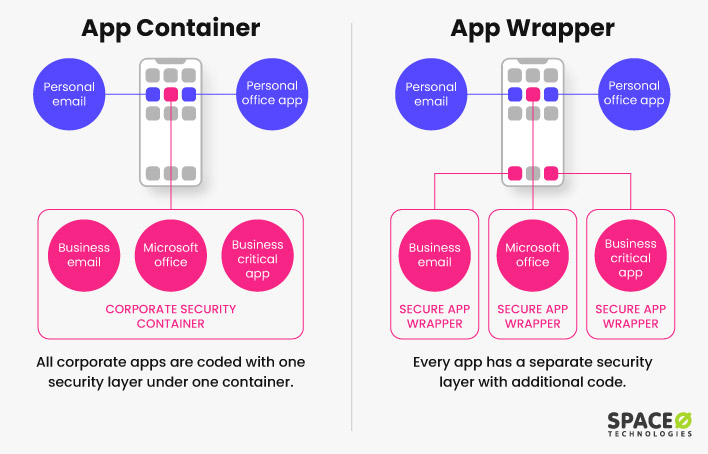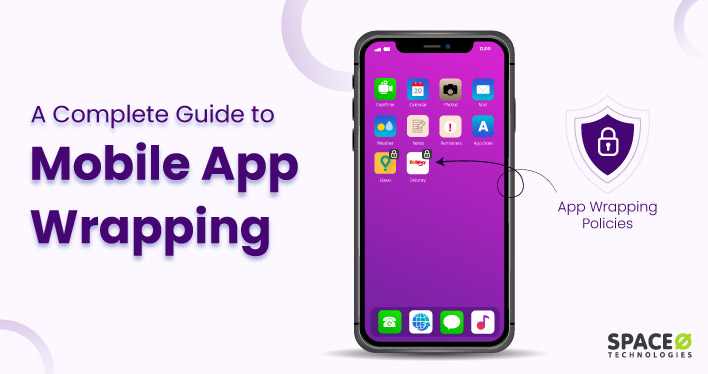In this fast-paced digital world, mobile app wrapping is the need of the hour. As more and more organizations are encouraging the culture of BYOD (bring your own device), it is getting difficult to keep crucial corporate data safe.
According to MarketResearchFuture, the market size of BYOD is estimated to reach USD 587.3 Billion by 2030. However, it gets difficult for organizations to have full control over personally-owned devices and track daily actions or fully eliminate the threat of data breaches.
This is where organizations must have wrapped apps in order to protect crucial business data by segregating corporate data from personal data. Having a decade of experience in mobile app development, we have come up with this blog to talk on:
- What and how does app wrapping work?
- Benefits of app wrapping for a business
- App wrapping policies and tools
Let’s get started.
Table of Contents
What is Mobile App Wrapping?
App wrappers will help you set policies to safely download an app from the internal app stores. The enterprise mobility management (EMM) strategy will ensure that cybercriminals do not compromise or hack any sensitive data.
Want to Build a Secure Enterprise Mobile App?
Over 200 specialized mobile app developers build powerful, secure iOS and Android apps.

When a business uses this technique to add an extra layer of security and management features to mobile apps it is known as enterprise app wrapping. It helps IT admins to control access, enforce policies, and monitor usage without modifying the app’s original source code.
However, app wrapping is not limited to business or security use and it can also be used to add other features such as analytics or advertising to an existing application.
But if you are thinking about how wrapping differs from containerization, you need to check the next section.
App Wrapping vs Containerization: What is The Difference?
The basic difference between app wrapping and app containerization is that app wrapping allows securing apps by adding additional code. This code is usually added to the app’s binary code to modify the app behavior like enabling extra security measures and limiting access to certain content.

App wrapping is the process of securing corporate applications by adding a secured layer to each application. This process protects the data and is independent of platform versions, unlike containerization. Wrapping is in demand as it empowers IT admins to control the security of apps.
In app containerization, every single app is wrapped in a secure environment of a ‘container’. This container provides an extra layer of security making it difficult for users to access the application. So even a single breach can compromise other apps associated with a company.
Now that we understand the difference between app wrapping and containerization, let’s move toward the increasing demand for app wrapping in different organizations. The next section includes the benefits of app wrapping.
Why Do Businesses Use App Wrapping?
There are several reasons behind a business using app wrapping. Have a look at the following top reasons for businesses to use wrapped apps.
- Wrapping your application gives you complete ability to add security features and control access to the app
- App wrapping prevents data from being compromised on personally-owned devices
- Admin is able to restrict copy-paste activity to prevent corporate data theft from the app
- You can also impose the operating system restrictions with app wrapping
Moving ahead, we will also discuss how app wrapping works. From reviewing the requirements to ensuring the app works seamlessly, we have 7 steps to follow for app wrapping.
How Does App Wrapping Work?
You will apply a management layer in order to wrap an app. For this, you might also need to use software tools, depending on the project requirements.
Moreover, here are the 7 steps you will follow to wrap a mobile app.
- Check the app wrapping prerequisites
- Review the compatibility of the app
- Install the wrapping tool or software
- Back up the version of your mobile app
- Upload the app and implement the policies
- Fix the errors and retest
- Ensure that the mobile app is working on all devices
Now, let’s move ahead to discuss the use cases for app wrapping. This will help you get inspired and give you the vision to implement an app-wrapping strategy.
4 Common Use Cases for App Wrapping
App wrapping allows businesses in many ways, not just protecting crucial information. It has got many purposes that you need to know to understand the usage of app wrapping in a better way.
Here are four use cases of using app wrapping.
- To save money and utilize resources wisely
- To provide pre-existing software and additional elements if needed
- To allow users to pick and choose various element options and gain complete control
- To allow the limitation of capabilities a device has, including camera or microphone accessibility
Despite the benefits and usage of mobile app wrapping, it comes with its own limitations that you need to know before making any vital decision.
What are the Limitations of App Wrapping?
Let’s quickly discuss the 4 disadvantages of using app wrapping in order to protect the data of a mobile app.
- There is no standard process for implementing the wrapping strategy because EMM vendors implement it in their own way
- There are often chances of missing some system calls, which results in leakages and insecure implementations
- A wrapped app does not get support from Google Play Store. Therefore, you can host them only on an EMM’s private app store
- You will not get support from 3rd party APIs, as wrapping simply means rebuilding and re-signing applications
Now, let’s check some of the top app wrapping tools that will help you simplify the overall wrapping process.
7 Best Mobile App Wrapping Tools
An app wrapping tool helps you add an extra layer of security to prevent crucial business data. In this section, we are going to discuss the top 7 mobile app wrapping tools.
| Logo | Wrapping Tool | Description |
|---|---|---|
 | Microsoft Intune | Microsoft Intune is a cloud-based unified endpoint management (UEM) service that enables protection policies for iOS and Android apps without changing the code. |
 | AirWatch by VMware | AirWatch by VMware allows organizations to protect all enterprise-grade applications by making small changes to the code. |
 | IBM MaaS360 | IBM MaaS360 is an enterprise mobility management (EMM) platform that offers smartphones visibility and control. |
 | MobileIron AppConnect | AppConnect is a MobileIron feature that primarily focuses on protecting the data of iOS and Android apps by containerizing them. |
 | Symantec Mobile App Protection | Symantec Mobile App Protection is a security analysis engine based on Appthority technology that helps in analyzing millions of apps to find malicious and unwanted behaviors. |
 | Citrix XenMobile | Citrix XenMobile is the best solution to prevent and manage mobile app data. Its features include multi-factor single sign-on, sandboxed apps, and a mobile application management strategy. |
 | Apperian EASE | Apperian EASE is an excellent app security and management tool that helps users to wrap a new layer of protection to the app. |
Moreover, there are various app wrapping policies that enhance the overall wrapping process. Have a look at these app wrapping policies.
3 Different App Wrapping Policies
There are a diverse set of app wrapping policies that you can directly apply without making any changes to the app code and requiring an SDK.
1. Security Policies: This policy helps you create “self-defending” apps that have the ability to protect themselves. Security policies include FIPS 140-2 encryption, copy/paste protection, jailbreak detection, and run-time integrity check.
2. Management Policies: This policy simplifies the management process and keeps apps updated across a large user population. Administrators have the ability to enable or disable apps at any time and make them visible to users based on different roles.
3. Analytic Policies: This policy is implemented to receive actionable and app-level insights for using the apps. You also get a dashboard view to check information graphically.
Want to Hire Experienced Mobile App Developers?
Space-O is a leading app development company that offers a flexible hiring model that exactly matches your project requirements.
Looking for more answers on the wrapping of a mobile application? Check the following section to find the top frequently asked questions.
Frequently Asked Questions About Mobile App Wrapping
Can an APK be wrapped?
Yes, it is also possible to wrap an APK.
Here are the following options that you can use to wrap APKs.
- Online Wrapper
- There are often chances of missing some system calls, which results in leakages and insecure implementations
- Command Line Wrapper
- Gradle Plugin
Is app wrapping enough for app security?
App wrapping alone can’t help to keep the mobile app secure. As more cyber-attackers are targeting applications, you also need a device-level management solution like an MDM or a UEM, along with wrapping to keep your data and devices safe and secure.
Can app wrapping be used to add new features or functionality to an app?
No, app wrapping simply allows you to add an extra layer of security to the app without changing any feature or functionality.
Ready to Wrap Your Mobile App?
Through this guide, you get to know a lot of essential information on mobile app wrapping. In short, by implementing the mentioned practices, steps, and tools, you will be able to wrap and secure mobile apps.
In case you want help in order to apply security measures by wrapping apps, then get in touch with us through the ‘Contact Us’ page. Our experienced technical consultant will get back to you within 48 hours.




